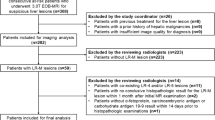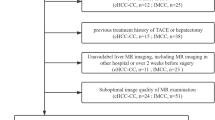Abstract
Objective
To identify the reliable imaging features and added-value of ancillary imaging features for differentiating hepatocellular carcinoma (HCC) and intrahepatic mass-forming cholangiocarcinoma (IMCC) assigned to LI-RADS M on Gd-BOPTA-enhanced MRI.
Methods
This retrospective study included 116 liver observations assigned to LI-RADS M, including 82 HCC and 34 IMCC histologically confirmed. Before and after adding ancillary imaging features, all variables with a p-value of < 0.05 in univariable analysis were entered into a multivariable logistic regression analysis to build diagnostic model 1 and model 2 to find reliable predictors of HCC diagnosis. Receiver operating characteristic (ROC) analysis and the DeLong test were used to compare the two models.
Results
Forty-nine of 82(59.8%) HCCs had a considerably higher frequency of enhancing “capsule” compared with IMCCs (p < 0.001). Based on LI-RADS major and LR-M features and clinical-pathologic factors, an elevated AFP level (OR = 10.676, 95%CI = 2.125–4.470, p = 0.004) and enhancing “capsule” (OR = 20.558, 95%CI = 4.470–94.550, p < 0.001) were extracted as independent risk factors in Model 1. After adding ancillary imaging features, Male (OR = 23.452, 95%CI = 1.465–375.404, p = 0.026), enhancing “capsule” (OR = 13.161, 95%CI = 1.725–100.400, p = 0.013), septum (OR = 17.983, 95%CI = 1.049–308.181, p = 0.046), small-scale central HBP hyperintensity (OR = 44.386, 95%CI = 1.610–1223.484, p = 0.025) were confirmed as independent significant variables associated with HCC. Model 2 demonstrated significantly superior AUC (0.918 vs 0.845, p = 0.021) compared with Model 1. When any two or more predictors in model 2 were satisfied, sensitivity was 91.46%, and accuracy was at the top (87.93%).
Conclusion
Enhancing “capsule” was a reliable imaging feature to help identify HCC. Adding ancillary imaging features improved sensitivity and accuracy for HCC diagnosis with differentiation from IMCC in LR-M.






Similar content being viewed by others
References
Radiology ACo. American College of Radiology (2018) CT/MRI LI-RADS version2018. In. https://www.acr.org/Clinical-Resources/Reporting-and-Data-Systems/LI-RADS/CT-MRI-LI-RADS-v2018.
Tang A, Bashir MR, Corwin MT, et al. Evidence Supporting LI-RADS Major Features for CT- and MR Imaging-based Diagnosis of Hepatocellular Carcinoma: A Systematic Review. Radiology 2018; 286:29-48
Fowler KJ, Potretzke TA, Hope TA, Costa EA, Wilson SR. LI-RADS M (LR-M): definite or probable malignancy, not specific for hepatocellular carcinoma. Abdominal radiology 2018; 43:149-157
Lee SM, Lee JM. LI-RADS Version 2017 versus Version 2018: Diagnosis of Hepatocellular Carcinoma on Gadoxetate Disodium-enhanced MRI. 2019; 292:655–663
Kierans AS, Makkar J, Guniganti P, et al. Validation of Liver Imaging Reporting and Data System 2017 (LI-RADS) Criteria for Imaging Diagnosis of Hepatocellular Carcinoma. Journal of magnetic resonance imaging : JMRI 2019; 49:e205-e215
van der Pol CB, Lim CS, Sirlin CB, et al. Accuracy of the Liver Imaging Reporting and Data System in Computed Tomography and Magnetic Resonance Image Analysis of Hepatocellular Carcinoma or Overall Malignancy-A Systematic Review. Gastroenterology 2019; 156:976-986
Cardinale V, Semeraro R, Torrice A, et al. Intra-hepatic and extra-hepatic cholangiocarcinoma: New insight into epidemiology and risk factors. World journal of gastrointestinal oncology 2010; 2:407-416
Bruix J, Sherman M. Management of hepatocellular carcinoma: an update. Hepatology (Baltimore, Md) 2011; 53:1020-1022
Gao Y, Lyu L, Feng Y, Li F, Hu Y. A review of cutting-edge therapies for hepatocellular carcinoma (HCC): Perspectives from patents. International journal of medical sciences 2021; 18:3066-3081
Schneider G, Altmeyer K, Kirchin MA, et al. Evaluation of a novel time-efficient protocol for gadobenate dimeglumine (Gd-BOPTA)-enhanced liver magnetic resonance imaging. Investigative radiology 2007; 42:105-115
Scali EP, Walshe T, Tiwari HA, Harris AC, Chang SD. A Pictorial Review of Hepatobiliary Magnetic Resonance Imaging With Hepatocyte-Specific Contrast Agents: Uses, Findings, and Pitfalls of Gadoxetate Disodium and Gadobenate Dimeglumine. Canadian Association of Radiologists journal = Journal l'Association canadienne des radiologistes 2017; 68:293–307
Fujita N, Nishie A, Asayama Y, et al. Hyperintense Liver Masses at Hepatobiliary Phase Gadoxetic Acid-enhanced MRI: Imaging Appearances and Clinical Importance. Radiographics : a review publication of the Radiological Society of North America, Inc 2020; 40:72–94
Mamone G, Marrone G, Caruso S, et al. Intrahepatic mass-forming cholangiocarcinoma: enhancement pattern on Gd-BOPTA-MRI with emphasis of hepatobiliary phase. Abdominal imaging 2015; 40:2313-2322
Choi SY, Kim YK. Added value of ancillary imaging features for differentiating scirrhous hepatocellular carcinoma from intrahepatic cholangiocarcinoma on gadoxetic acid-enhanced MR imaging. 2018; 28:2549-2560
Hwang J, Kim YK, Min JH, et al. Capsule, septum, and T2 hyperintense foci for differentiation between large hepatocellular carcinoma (>/=5 cm) and intrahepatic cholangiocarcinoma on gadoxetic acid MRI. European radiology 2017; 27:4581-4590
Park YS, Lee CH, Kim JW, Shin S, Park CM. Differentiation of hepatocellular carcinoma from its various mimickers in liver magnetic resonance imaging: What are the tips when using hepatocyte-specific agents? World journal of gastroenterology 2016; 22:284-299
Choi SH, Lee SS, Park SH, et al. LI-RADS Classification and Prognosis of Primary Liver Cancers at Gadoxetic Acid-enhanced MRI. Radiology 2019; 290:388-397
Kim YY, Kim MJ. Hepatocellular Carcinoma versus Other Hepatic Malignancy in Cirrhosis: Performance of LI-RADS Version 2018. 2019; 291:72-80
Ishigami K, Yoshimitsu K, Nishihara Y, et al. Hepatocellular carcinoma with a pseudocapsule on gadolinium-enhanced MR images: correlation with histopathologic findings. Radiology 2009; 250:435-443
Lim K, Kwon H, Cho J. Inter-reader agreement and imaging-pathology correlation of the LI-RADS M on gadoxetic acid-enhanced magnetic resonance imaging: efforts to improve diagnostic performance. Abdominal radiology 2020; 45:2430-2439
Manieri E, Herrera-Melle L. Adiponectin accounts for gender differences in hepatocellular carcinoma incidence. 2019; 216:1108-1119
Greten TF. Gender disparity in HCC: Is it the fat and not the sex? The Journal of experimental medicine 2019; 216:1014-1015
Liver EAftSot. EASL Clinical Practice Guidelines: Management of hepatocellular carcinoma. Journal of hepatology 2018; 69:182–236
Liang B, Zhong L, He Q, et al. Diagnostic Accuracy of Serum CA19-9 in Patients with Cholangiocarcinoma: A Systematic Review and Meta-Analysis. Medical science monitor : international medical journal of experimental and clinical research 2015; 21:3555-3563
Jiang H, Song B, Qin Y, et al. Diagnosis of LI-RADS M lesions on gadoxetate-enhanced MRI: identifying cholangiocarcinoma-containing tumor with serum markers and imaging features. European radiology 2021; 31:3638-3648
Sheng RF, Zeng MS, Ji Y, Yang L, Chen CZ, Rao SX. MR features of small hepatocellular carcinoma in normal, fibrotic, and cirrhotic livers: a comparative study. Abdominal imaging 2015; 40:3062-3069
Cerny M, Chernyak V, Olivie D, et al. LI-RADS Version 2018 Ancillary Features at MRI. Radiographics : a review publication of the Radiological Society of North America, Inc 2018; 38:1973–2001
Park HJ, Jang KM, Kang TW, et al. Identification of Imaging Predictors Discriminating Different Primary Liver Tumours in Patients with Chronic Liver Disease on Gadoxetic Acid-enhanced MRI: a Classification Tree Analysis. European radiology 2016; 26:3102-3111
Horvat N, Nikolovski I, Long N, et al. Imaging features of hepatocellular carcinoma compared to intrahepatic cholangiocarcinoma and combined tumor on MRI using liver imaging and data system (LI-RADS) version 2014. Abdominal radiology 2018; 43:169-178
Bae JS, Kim JH. Diagnostic accuracy of gadoxetic acid-enhanced MR for small hypervascular hepatocellular carcinoma and the concordance rate of Liver Imaging Reporting and Data System (LI-RADS). 2017; 12:e0178495
Min JH, Kim YK, Choi SY, et al. Differentiation between cholangiocarcinoma and hepatocellular carcinoma with target sign on diffusion-weighted imaging and hepatobiliary phase gadoxetic acid-enhanced MR imaging: Classification tree analysis applying capsule and septum. European journal of radiology 2017; 92:1-10
El Jabbour T, Lagana SM, Lee H. Update on hepatocellular carcinoma: Pathologists' review. World journal of gastroenterology 2019; 25:1653-1665
Acknowledgements
No
Funding
Educational Research Project for Young and Middle‐aged Teachers of Fujian Provincial Department of Education (JAT200167).
Author information
Authors and Affiliations
Corresponding author
Ethics declarations
Conflict of interest
The authors declare that there is no conflict of interest.
Ethical approval
Institutional Review Board approval was obtained.
Informed consent
The requirement for patient informed consent was waived due to the retrospective nature of this study.
Additional information
Publisher's Note
Springer Nature remains neutral with regard to jurisdictional claims in published maps and institutional affiliations.
Rights and permissions
About this article
Cite this article
Zheng, W., Huang, H., She, D. et al. Added-value of ancillary imaging features for differentiating hepatocellular carcinoma from intrahepatic mass-forming cholangiocarcinoma on Gd-BOPTA-enhanced MRI in LI-RADS M. Abdom Radiol 47, 957–968 (2022). https://doi.org/10.1007/s00261-021-03380-6
Received:
Revised:
Accepted:
Published:
Issue Date:
DOI: https://doi.org/10.1007/s00261-021-03380-6




